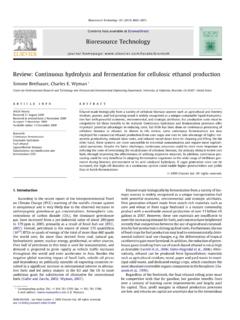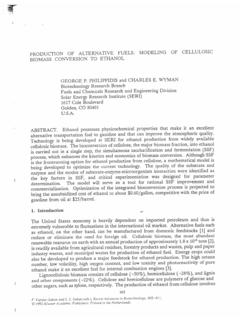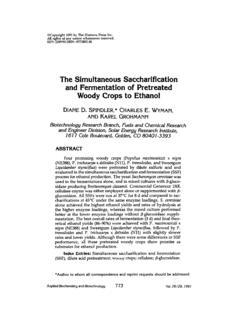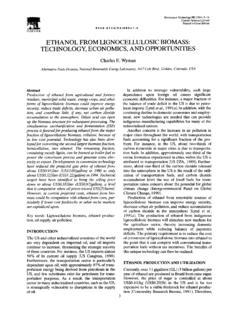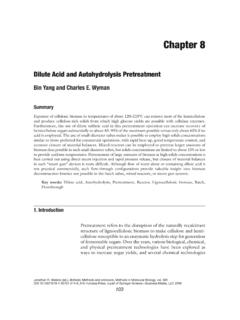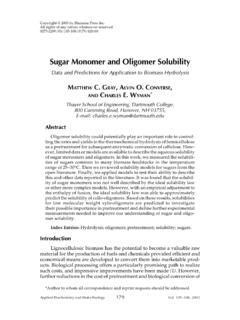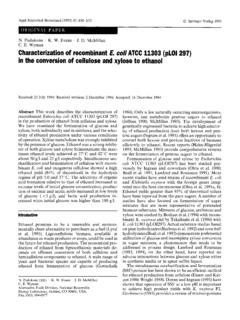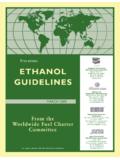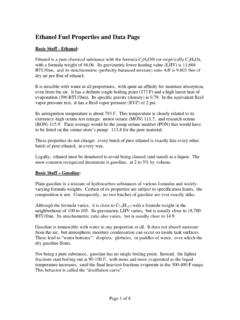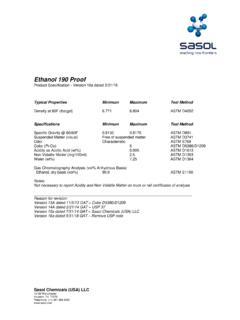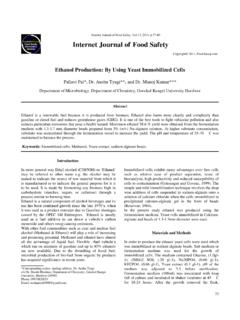Transcription of Cellulosic Ethanol: A Unique Sustainable Liquid ...
1 381 RESOURCES BIOMASS & BIOFUELS MRS BULLETIN VOLUME 33 APRIL 2008 Harnessing Materials for EnergyWhat Is Cellulosic Biomass?Although ethanol is now made from the sugars in the starch fraction of corn and other crops and from the sugar in sugar-cane, a much greater impact for ethanol in terms of fuel use could be realized if the sugars from more recalcitrant Cellulosic biomass could be converted to ethanol . Cellulosic biomass is the structural portion of plants and includes agricultural ( , corn stover, which is all of the above-ground portion of the corn plant, excluding the grain) and forestry ( , sawdust) residues, major fractions of municipal solid waste ( , waste paper and yard waste), and herbaceous ( , switchgrass) and woody ( , poplar) crops grown as energy Although distinctive in outward appearance, these materials all comprise about 40 50% cellulose and 20 30% hemicellulose, with lesser amounts of lignin and other compounds such as sugars, oils, and minerals.
2 Cellulose is a polymer of glucose sugar molecules that are physically linked together in a crystal-line structure to provide structural support for plants. Hemicellulose is also made up of sugars covalently joined together in long chains, but it generally includes five different sugars: arabinose, galactose, glucose, mannose, and xylose. In addition, hemicellulose is an amorphous, branched material. Lignin is a phenylpropene compound that can be viewed as a low-sulfur, immature Conversion of Cellulosic Biomass to EthanolThe overall approach to converting Cellulosic biomass to ethanol is outlined in Figure 1. Acids can break down the long chains in hemicellulose and cellulose to release the sugars comprising these materials through hydrolysis reactions, but because of their high specificity, enzymes known as cellulase can achieve higher yields of glucose from cellulose and are often However, to survive in nature, Cellulosic biomass has evolved a structure that resists enzymatic attack, and it must first be pretreated to better expose the cellulose to enzymes.
3 Over the years, bio-logical, chemical, mechanical, physical, and thermal pre-treatments have been tried, but currently, only methods that treat biomass at temperatures of about 80 200 C with one or more chemicals have been able to realize the high sugar yields vital to economic success. Leading thermochemical pretreatment options include dilute sulfuric acid, ammonia fiber expansion (AFEX), neutral pH, and lime, although the choice depends on many factors including the nature of the substrate, enzymes, and organisms and other process ,4A portion of pretreated biomass can be used to feed a fun-gus or other organism that produces cellulase that can then be added to the bulk of the pretreated solids to release glucose from cellulose.
4 In addition, the enzymes must be capable of releasing sugars contained in hemicellulose if the pretreat-ment step does not fully accomplish this. Then, an organism is added to ferment all of the sugars to ethanol . Although con-ventional yeasts ferment glucose and other sugars containing six carbon atoms efficiently, they do not use the five-carbon sugars arabinose and xylose well, and bacteria and yeasts have been genetically modified to accomplish this task. Following fermentation, the broth then passes into a distillation system for recovery and concentration of the ethanol , while the lignin and other portions not converted into ethanol can be burned to generate all of the heat and electricity needed to run the entire process, with excess power left to export to homes and busi-nesses.
5 The sugars released during pretreatment and/or enzy-matic hydrolysis of hemicellulose and cellulose could also be biologically or chemically converted into other products in addition to ethanol , and lignin, an aromatic compound, could be employed to produce various materials such as adhesives and of Cellulosic EthanolPetroleum provides more energy internationally than any other source, accounting for about 35% of total energy pro-duced, and unstable regions of the world hold the bulk of all known reserves. In addition, because over half of the petro-leum is used for a transportation sector that is almost totally dependent on petroleum, developing alternative sources of Liquid transportation fuels is vital to alleviating this perilous dependence,6 with biomass uniquely suited to sustainably meet this need.
6 As one measure of its abundance, the Department of Agriculture (USDA) and Department of Energy (DOE) recently projected that about billion dry tons of Cellulosic biomass could be produced annually in the United States, from which enough ethanol could potentially be made to replace over half of the gasoline now used in the Cellulosic ethanol : A Unique Sustainable Liquid Transportation FuelCharles E. Wyman (University of California Riverside, USA)Figure 1. Overall process flow diagram illustrating the important operations in the biological conversion of Cellulosic biomass to steps toproduce enzymes,hydrolyze biomass,and ferment sugarsCellulosicbiomassPretreatment toopen up biomassto enzymesEthanol recoveryand purificationResidue processingBoiler andpower generationFuel ethanolProcess effluentsExportedelectricityLignin andother residuesProcess heatand power382 RESOURCES BIOMASS & BIOFUELSMRS BULLETIN VOLUME 33 APRIL 2008 Harnessing Materials for EnergyThus, Cellulosic ethanol production could play a major role in significantly reducing petroleum imports, improving energy security.
7 Creating rural agricultural and manufacturing jobs, and dramatically cutting the trade deficit for oil has higher octane content than regular or even pre-mium gasoline; this property, coupled with a higher heat of vaporization, permits operation with a higher compression ratio when ethanol is used as a pure fuel. The result can be considerably better efficiency compared to gasoline in terms of miles powered per unit energy content of the fuel, compen-sating to some degree for the somewhat lower energy content of ethanol compared to gasoline. Thus, ethanol must sell for about 67 80% of the price of gasoline to provide equivalent cost per distance traveled.
8 However, a larger portion of etha-nol is used as blends with gasoline, and all automobile manu-facturers warrant their vehicles for this use and employ appropriate materials in fuel lines to accommodate the some-what greater corrosivity of blended ethanol . Although pure ethanol has low evaporative losses that can cause smog, low-level blends with gasoline increase evaporation somewhat, potentially negating some of the benefits for reducing tailpipe addition to the powerful strategic and economic attributes of Cellulosic ethanol , the use of lignin to power the Cellulosic ethanol production facility and the low fossil fuel inputs required to plant, grow, harvest, and transport Cellulosic bio-mass and to transport ethanol to its destination result in very favorable energy balances for Cellulosic ethanol .
9 As a result, less than 10% of the ethanol energy produced has required fos-sil energy Even more importantly, these low fossil fuel requirements translate into very low net greenhouse gas emis-sions of less than 12% of those of gasoline;8 this ratio could be improved if the electricity exported to the power grid displaced requirements for coal and more renewable fuels were employed in all In addition, more carbon dioxide could be removed than released in the process if the virtually pure carbon dioxide produced during fermentation could be sequestered in underground caverns or through other techniques being and Economic ProgressCellulosic biomass is a low-cost feedstock.
10 With a cost of about $40/dry ton being competitive with petroleum at about $13/barrel on an equivalent-energy-content Although the resistance of biomass to biological breakdown has been his-torically expensive to overcome, an important advantage to using biological processes for this operation is that we can employ the power of modern biotechnology to dramatically improve the process and reduce processing In this vein, advances in pretreatment, enzymes, and fermentative organ-isms as well as process integration have lowered the costs from about $4 5/gal of ethanol in the early 1980s to being competi-tive with ethanol made from corn Furthermore, costs as low as about $ could be realized if leap-forward tech-nology advances were made in the most expensive processing steps: pretreatment and the biological conversion steps of enzyme production, enzymatic hydrolysis, and ,15 For example, genetically modifying organisms to make their own enzymes while also fermenting the sugars they release to ethanol with high yields is one promising approach.
